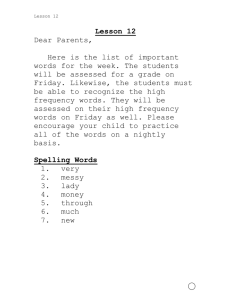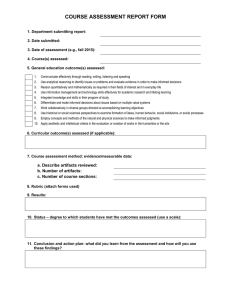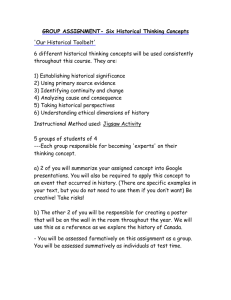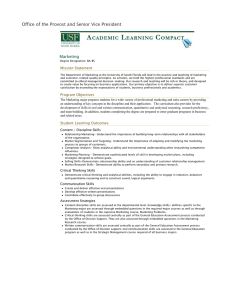Chabot College Program Review Report 2014 ‐2015
advertisement
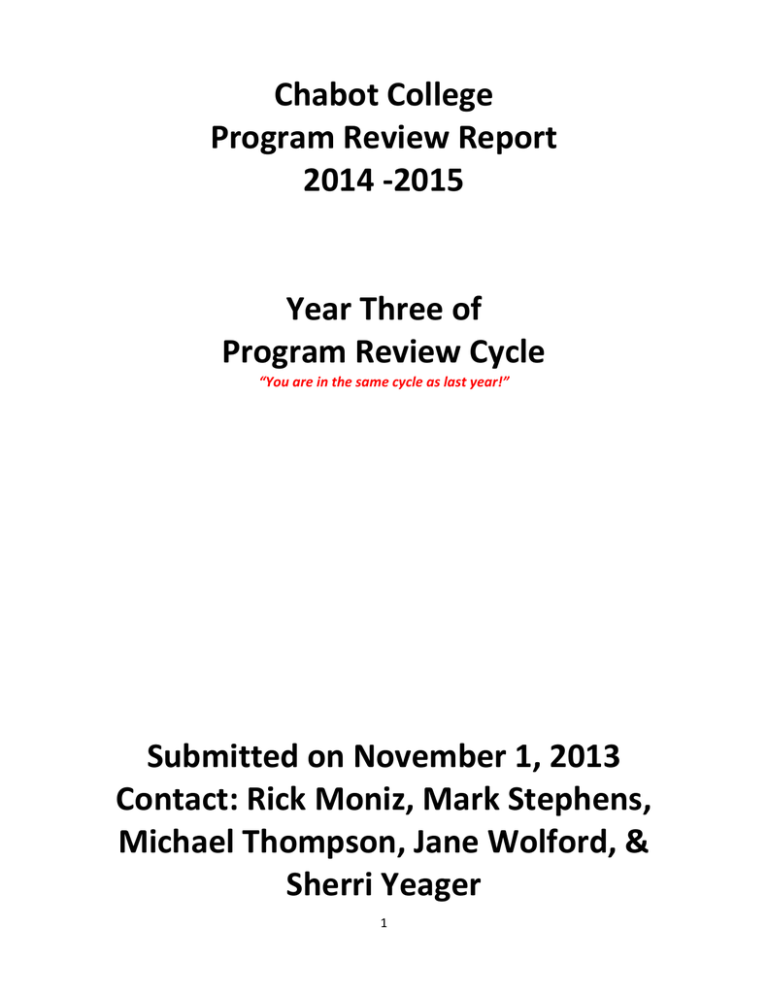
Chabot College Program Review Report 2014 ‐2015 Year Three of Program Review Cycle “You are in the same cycle as last year!” Submitted on November 1, 2013 Contact: Rick Moniz, Mark Stephens, Michael Thompson, Jane Wolford, & Sherri Yeager 1 Appendix B2: “Closing the Loop” Assessment Reflections (See Attached forms) Course Semester assessment data gathered Number of sections offered in the semester Number of sections assessed Percentage of sections assessed Semester held “Closing the Loop” discussion Faculty members involved in “Closing the Loop” discussion Form Instructions: Part I: CLO Data Reporting. For each CLO, obtain Class Achievement data in aggregate for all sections assessed in eLumen. Part II: CLO Reflections. Based on student success reported in Part I, reflect on the individual CLO. Part III: Course Reflection. In reviewing all the CLOs and your findings, reflect on the course as a whole. PART I: COURSE‐LEVEL OUTCOMES – DATA RESULTS CONSIDER THE COURSE‐LEVEL OUTCOMES INDIVIDUALLY (THE NUMBER OF CLOS WILL DIFFER BY COURSE) HISTORY 7 FOR SPRING 2012 (CLO) 1: Synthesize factual information and historical evidence from a variety of sources and identify the connections between them. (CLO) 2: The students will demonstrate a body of knowledge about and critical understanding of historical eras, their key events and ideas, and the process of change over time. Defined Target Scores* (CLO Goal) 48.6% assessed at 3 or 4 48.1% assessed at 3 or 4 (CLO) 3: Analyze the causes and consequences of political, 49.1% assessed at 3 or 4 economic and social change. (CLO) 4: Actual Scores** (eLumen data) 109 assessed: 18 assessed at 4 35 assessed at 3 29 assessed at 2 17 assessed at 1 10 assessed at 0 106 assessed: 24 assessed at 4 27 assessed at 3 26 assessed at 2 22 assessed at 1 27 assessed at 0 108 assessed: 22 assessed at 4 31 assessed at 3 32 assessed at 2 12 assessed at 1 12 assessed at 0 CONSIDER THE COURSE‐LEVEL OUTCOMES INDIVIDUALLY (THE 2 Defined Target Actual Scores** NUMBER OF CLOS WILL DIFFER BY COURSE) HISTORY 12 Scores* (CLO Goal) (CLO) 1: Evaluate how the voyages of exploration brought 70% or greater the Spaniards to California and why they delayed settlement. (CLO) 2: Identify how the Gold Rush transformed (eLumen data) 77% 70% or greater 77% 70% or greater 77% California from a frontier society to a rural mining society and into an industrialized urban society by the end of the 19th century (CLO) 3: Explain how the Constitution of California broke with past practice of statehood process established by Congress and the Constitution. Identify the salient features of the California's first constitution. CONSIDER THE COURSE‐LEVEL OUTCOMES INDIVIDUALLY (THE NUMBER OF CLOS WILL DIFFER BY COURSE)HISTORY 20 (CLO) 1: Synthesize factual information and historical evidence from a variety of sources and identify the connections between them. Defined Target Scores* (CLO Goal) 48.6% Assessed at 3 or 4 (CLO) 2: The students will demonstrate a body of knowledge about and critical understanding of historical eras, their key events and ideas, and the process of change over time. (CLO) 3: : Analyze the causes and consequences of political, economic and social change. CONSIDER THE COURSE‐LEVEL OUTCOMES INDIVIDUALLY (THE NUMBER OF CLOS WILL DIFFER BY COURSE) 3 45.9% Assessed at 3 or 4 Actual Scores** (eLumen data) 74 Assessed: 13 Assessed at 4 23 Assessed at 3 27 Assessed at 2 7 Assessed at 1 4 Assessed at 0 74 10 Assessed at 4 24 Assessed at 3 29 Assessed at 2 7 Assessed at 1 4 Assessed at 0 43.2% Assessed at 3 or 4 10 Assessed at 4 22 Assessed at 3 28 Assessed at 2 7 Assessed at 1 4 Assessed at 0 Defined Target Scores* (CLO Goal) Actual Scores** (eLumen data) HISTORY 27 FOR SPRING 2012 (CLO) 1: Synthesize factual information and historical 61 assessed: 17 assessed at 4 evidence from a variety of sources and identify the 17 assessed at 3 connections between them. 19 assessed at 2 8 assessed at 1 0 assessed at 0 64% assessed at 61 assessed: (CLO) 2: The students will demonstrate a body of 3 or 4 17 assessed at 4 knowledge about and critical understanding of historical 22 assessed at 3 eras, their key events and ideas, and the process of change 12 assessed at 2 over time. 10 assessed at 1 0 assessed at 0 55.8% assessed at 3 or 4 (CLO) 3: Analyze the causes and consequences of political, 60.6% assessed at 3 or 4 economic and social change. 4 61 assessed: 13 assessed at 4 24 assessed at 3 19 assessed at 2 5 assessed at 1 0 assessed at 0 If more CLOs are listed for the course, add another row to the table. * Defined Target Scores:What scores in eLumen from your students would indicate success for this CLO? (Example: 75% of the class scored either 3 or 4) **Actual scores: What is the actual percent of students that meet defined target based on the eLumen data collected in this assessment cycle? 5 PART II: COURSE‐ LEVEL OUTCOME REFLECTIONS A. COURSE‐LEVEL OUTCOME (CLO) 1: 1. How do your current scores match with your above target for student success in this course level outcome? This response will be the History discipline’s response for each CLO reflection. It is our contention that establishing any target score after only one round of assessment would be arbitrary and only reflect our “hopes” disconnected from the reality of our classrooms. At best, these numbers might be used as a base from which following assessments could be measured. Moreover, since these measures will inevitably change as we assess different courses with different students over different semesters, it is difficult to tease out what these scores truly measure. Ultimately, we feel that this process, rather than being led toward the goals of pedagogical reflection and faculty development, is largely software‐driven. The resulting data seems, at best, faulty, and at worst, an increasingly cynical attempt to jump through an accreditation “hoop,” divorced from any real desire to achieve reflection and reform. We, again, urge the appropriate committees and administrators to allow disciplines to begin developing and piloting different ways of achieving meaningful assessment and fulfilling this accreditation requirement. 2. Reflection: Based on the data gathered, and considering your teaching experiences and your discussions with other faculty, what reflections and insights do you have? B. COURSE‐LEVEL OUTCOME (CLO) 2: 1. How do your current scores match with your above target for student success in this course level outcome? 6 2. Reflection: Based on the data gathered, and considering your teaching experiences and your discussions with other faculty, what reflections and insights do you have? 7 C. COURSE‐LEVEL OUTCOME (CLO) 3: 1. How do your current scores match with your above target for student success in this course level outcome? 2. Reflection: Based on the data gathered, and considering your teaching experiences and your discussions with other faculty, what reflections and insights do you have? D. COURSE‐LEVEL OUTCOME (CLO) 4: 1. How do your current scores match with your above target for student success in this course level outcome? 2. Reflection: Based on the data gathered, and considering your teaching experiences and your discussions with other faculty, what reflections and insights do you have? E. COURSE‐LEVEL OUTCOME (CLO) 5: ADD IF NEEDED. 8 PART III: COURSE REFLECTIONS AND FUTURE PLANS 1. What changes were made to your course based on the previous assessment cycle, the prior Closing the Loop reflections and other faculty discussions? This response will be the History discipline’s response for each Course reflection. The changes that we as faculty members make to our classes come through our engagement with our students in our courses every day. As professional educators, we respond to how our lesson plans achieve (or don’t) our daily goals, how our students perform on their assignments, papers and exams, and our continuing attempt to keep up with the latest scholarship in our fields. These are the ways that our courses change. The current process does not afford us the time or opportunity to actually share with each other, as discipline members, the ways in which we consistently strive to reach and teach our students more effectively. Yes, our classes change all the time. We only wish we were engaged in a process that facilitated and encouraged that positive change. 2. Based on the current assessment and reflections, what course‐level and programmatic strengths have the assessment reflections revealed? What actions has your discipline determined might be taken as a result of your reflections, discussions, and insights? 3. What is the nature of the planned actions (please check all that apply)? X Curricular X Pedagogical 9 Resource based Change to CLO or rubric X Change to assessment methods (Yes, please) Other:_________________________________________________________________ 10 Appendix C: Program Learning Outcomes Considering your feedback, findings, and/or information that has arisen from the course level discussions, please reflect on each of your Program Level Outcomes. Program: ________________________________________________ PLO #1: PLO #2: PLO #3: PLO #4: What questions or investigations arose as a result of these reflections or discussions? Explain: In Progress What program‐level strengths have the assessment reflections revealed? Strengths revealed: In Progress What actions has your discipline determined might be taken to enhance the learning of students completing your program? Actions planned: In Progress Program: ________________________________________________ PLO #1: PLO #2: PLO #3: 11 PLO #4: What questions or investigations arose as a result of these reflections or discussions? Explain: What program‐level strengths have the assessment reflections revealed? Strengths revealed: What actions has your discipline determined might be taken to enhance the learning of students completing your program? Actions planned: 12

